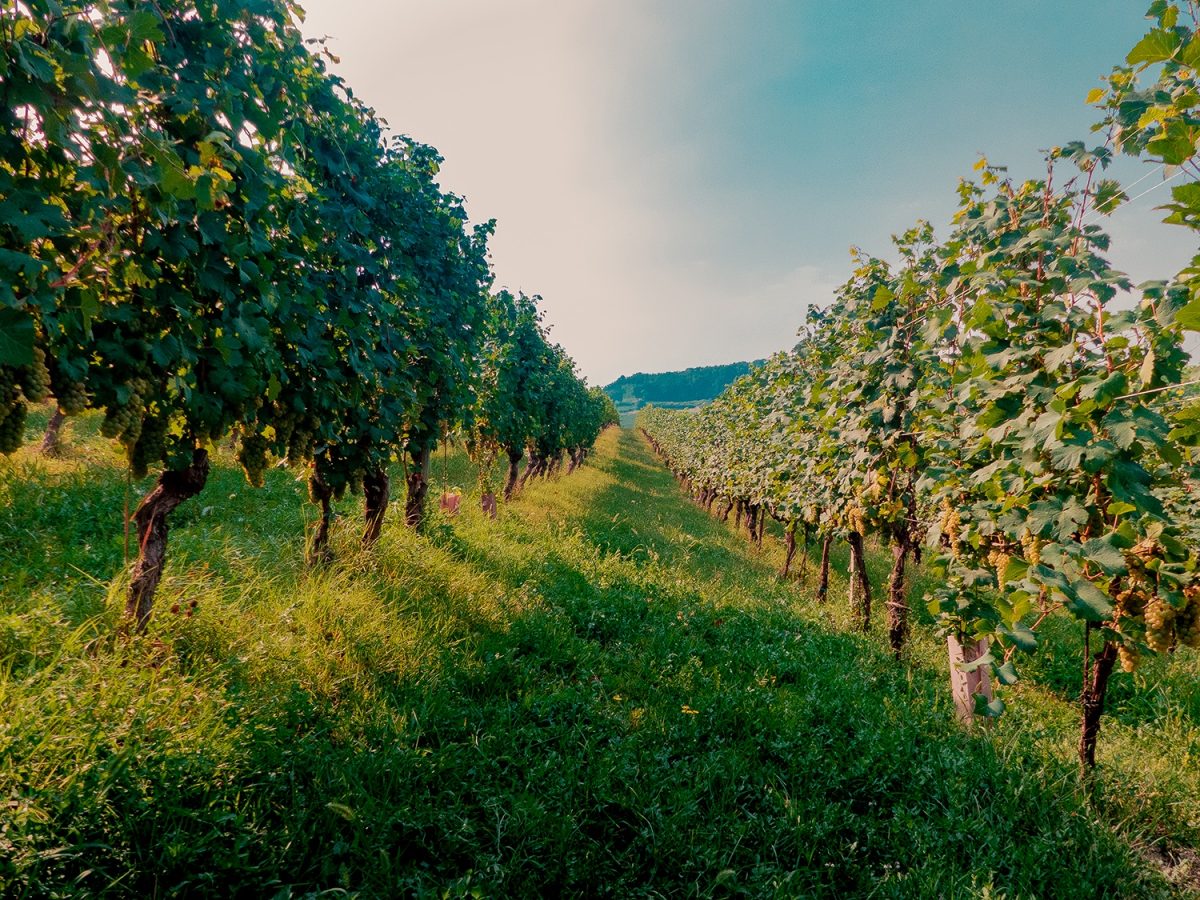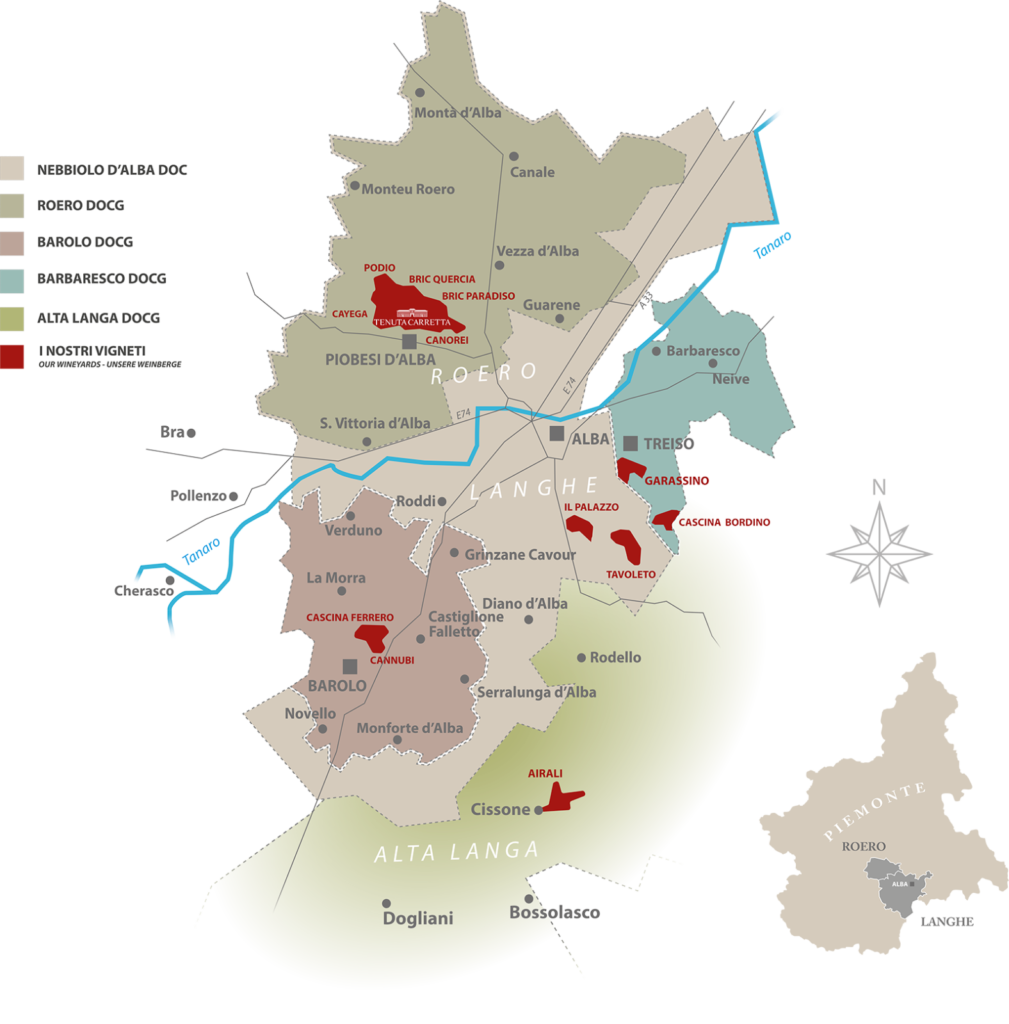The vineyards
80 hectares of vineyards in the Langhe and Roero

All the vineyards of Tenuta Carretta are part of the Langhe-Roero and Monferrato winemaking district, an extraordinary territory named a UNESO World Heritage Site in 2014, and which today, extends to about 80 hectares. In the 35 hectares that makeup a single plot that extends south to northwest as an amphitheatre around the winery, the grapes grown are for the most part arneis (for the Roero Arneis Cayega and Canorei), then nebbiolo (for the Roero Bric Paradiso), barbera (for the renowned Barbera d’Alba Bric Quercia) and favorita (the name given for vermentino in Roero).
But the property’s vineyards also extend close to the Langhe, such as 2.6 hectares in Barolo on the prestigious Cannubi hill, from which the nebbiolo grapes destined for the production of the celebrated Barolo Cannubi and Barolo Cannubi Riserve originate.
The vineyards of Cascina Bordino, 6.5 hectares of nebbiolo, like those of Garassino (4.5 hectares) are instead found in the municipality of Treiso and are destined for the production for its corresponding Barbaresco. While the nebbiolo grapes coming from the vineyard Tavoleto, in the municipality of Alba (8 hectares), produce its namesake Nebbiolo d’Alba.
Finally, dolcetto, which is found in its best habitat, in the vineyards of the Il Palazzo farmhouse, located in Madonna Como (Alba), where the namesake Dolcetto d’Alba is produced.

The Nebbiolo vineyards
It is the most ancient native black grape variety in Piedmont, and of the most noble and prestigious in Italy. Its name seems to originate from nebbia, the word for fog, because the late maturation of the grapes pushes the beginning of the harvest to the first mists of autumn. Or more likely, because the mature grapes appear covered in a bloom, a type of natural protective layer that reminds one of the colour of fog.
Nebbiolo needs careful attention and is very demanding in terms of the orientation and exposure of the vineyard as well as the processing and fertilization. The calcarious and tuffaceous soils are ideal for this vine, that needs terrain rich with sand and clay in the right proportions and which precociously buds in the first ten days of April.
The maturation, however, is late. Traditionally in the first half of October. Rather sensitive to sudden temperature fluctuations, it likes thermal excursions that characterize the passages between day and night, especially during ripening. But the richness of tannins in its skin requires, for the proper development of the polyphenolic substances that characterize this variety, hilly slopes well exposed to the sun, preferably south and west, with an altitude between 200 and 450m, sheltered from the wind and the cold spring days.
Tenuta Carretta is one of the few wineries to have vineyards of nebbiolo in all the original wine producing areas of the nebbiolo grape in the Langhe and Roero: Barolo, Barbaresco, Roero, Nebbiolo d’Alba and Langhe Nebbiolo.
The Arneis varietal
Arneis has always been cultivated in the hills of the Roero district. The first records of the varietal appear in official documents dating from the late fifteenth century, under the names “Reneysium” (or “Renesium”) and “Ornesium”; there is also mention of a vineyard consisting of “moscatellum et renexij” vines. The latter name would seem to refer expressly to what is now Bricco Renesio, in the municipality of Canale d’Alba.
In the eighteenth century, Arneis is mentioned as a grape of the same quality as Moscato, and which, like Moscato, is normally used to make sweet wines or a dry wine which is then used in the preparation of vermouth. It appears in nineteenth-century winery documents under the name “Arnesi white”, as compared to “white wine from miscellaneous grapes”.
In the early twentieth century Arneis suffered from the widespread crisis in wine-growing consequent upon the spread of phylloxera, after which it was sporadically grown as a table grape, or planted alongside rows of Nebbiolo vines to attract birds away from them (resulting in the nickname “white Nebbiolo”), as the grapes ripen earlier and are sweeter.
The first vineyards entirely planted with Arneis date back to the ’70s, when a number of growers began to produce an elegant dry white wine.
The Arneis grape buds relatively early, and is therefore best planted on hillsides which are not subject to frost in the spring. They do not flower until early June, and the grapes ripen in the second half of September.
A sustainable viticulture
In the vineyard, the productive philosophy of Tenuta Carretta are based in themes of sustainability (environmental, technical and economical). This is implemented through the use of integrated viticulture techniques, that allow for a limited use of chemical treatments for only when they are indispensable to protecting the harmonious development of the plant.
A vineyard managed adequately, besides safeguarding the soil integrity, exalts the quality of the grapes and produces wines of grand personality, that are faithful and recognizable to their land of origin.